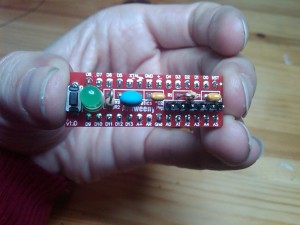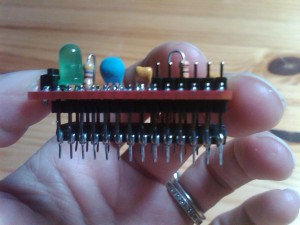Ardweeny adventures, part one
The parts bundle for the coasterbot includes a microcontroller to act as the brain of the robot. It is an Ardweeny, made by Solarbotics. Billed as the “smallest, handiest, bread-board friendly Arduino-compatible”, it literally fits on the back of the ATMega328 chip. It’s a pretty cool design, and incredibly small, as you can see in the pictures below:
The PCB board pins are lightly soldered to the chip pins, then the chip can be placed in a breadboard.
I was able to assemble the kit very easily, soldering the chip in upside down to keep solder off the bottom of its pins. Now to test! The Ardweeny needs a USB-FTDI cable or board in order to load programs onto it. I already had a board with the right form factor labelled “USB to Serial” lying around from an old MachineScience project. Thus I never ordered a new board. Unfortunately, upon closer inspection, I realized the MachineScience board had only 4 pins, while this one has 6. My guess is that there would be some way to get it to work — their functions are certainly similar — but an FTDI board is useful equipment, and not that expensive, so I ordered one and resigned myself to waiting a few days for a programming test.
I thought that I could at least see if I had put the kit together properly. I had heard that the Ardweeny ships with the Blink program already loaded, making the LED turn on and off. So I decided to power it up and see what happened. And there, as we say, my troubles began…
Becuase the Ardweeny is so small, it does not have a voltage regulator. You must give it exactly 5V for it to operate properly. The parts bundle includes a 5V voltage regulator that you can put together. But I already have a fancy powered breadboard that can convert its AC wall power to an exact 5V output. So it seemed reasonable to use it here. I put the Ardweeny in and saw…nothing. I eventually realized that I hadn’t pushed the chip in firmly on the breadboard, and more seriously, I had hooked up the wrong power option and was sending it 9V instead of 5V. The chip is only rated to 6V, so I wasn’t sure if I had fried it or not. I decided to put it aside for now.
The FTDI board arrived a few days later. I installed the drivers on my laptop and attempted to upload the Blink program to the Ardweeny. I got an error message. It seemed that the program was being sent, based on the various blinking lights, but not properly received. I tried various fixes on that computer, and tried another computer as well — which got me a new error message, but no progress.
I noticed that the FTDI board was not fitting very well. I had to apply pressure to keep it in place. It is designed to fit into the the male header pins jutting out from the top of the Ardweeny. (You can see them in front of my index finger in the second photo.) Eventually, I realized that I had soldered in the male headers upside down. The short pins were on top, rather than the long ones, and the long ones are needed to form a solid electrical connection.
This was a rookie mistake. That said, I am going to blame Solarbotics a bit, because in their manual, step 7, they picture the male headers upside down. I naively followed the picture, and that was incorrect.
So my choices were, attempt to unsolder all 28 pins of the chip without damaging it (assuming it wasn’t already fried), and remove it. This would be pretty tough as the chip is already held in place firmly by mechanical pressure alone. Then, I would have to unsolder the header pins and turn them around. All things considered, it seemed better to suck it up and pay $10 for a new kit.
There are only two places to get an Ardweeny: Solarbotics, and Jameco. At first I planned to order from Jameco, because I have used them before and like their order process. But then I saw the Ardweeny from them was $14…? I didn’t want to pay a 40% markup, so went back to Solarbotics, which also seemed to have better prices on some other parts I wanted to bundle with the order. I completed the order smoothly enough, but at the end, I was told that an e-mail receipt couldn’t be sent, yet my order would be placed anyway. Um. I went to the Contact part of the site, and filled in an request for my tracking information. Submitted that, and was told (again) that the e-mail couldn’t be sent.
This was two days ago. I went back to the Solarbotics site and the contact form still doesn’t work. I am going to call and see if the order was actually placed or not, because I am not feeling very confident about it. It is frustrating to always be waiting for parts to arrive. In general you have a choice between waiting two weeks for something or paying an outrageous shipping fee. I should buy stock in FedEx.
The news is not all bad — I have successfully modified one of the servomotors used to turn the wheels and make the robot move. That will be another post.
UPDATE: Solarbotics responded promptly to my phone message, and explained that they were having technical difficulties due to an office move. My order had been placed, and the kit arrived this afternoon.

